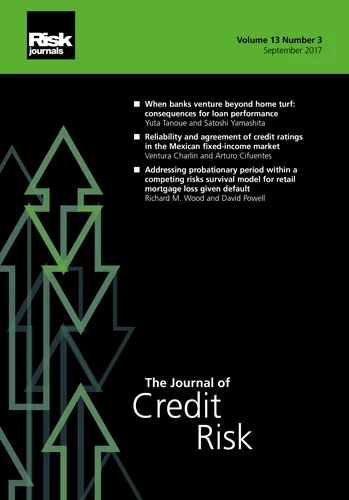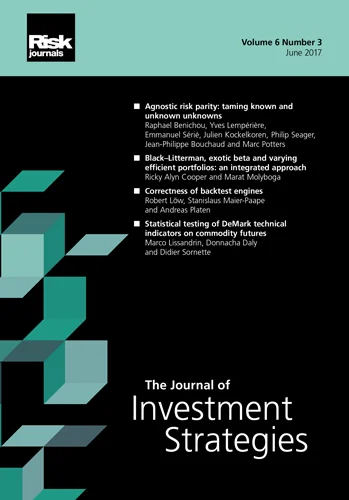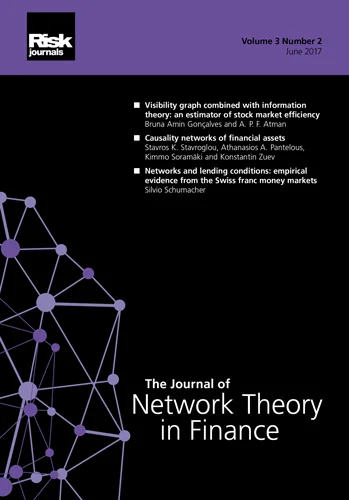Journal of Network Theory in Finance
ISSN:
2055-7809 (online)
Editor-in-chief: Ron Berndsen
Volume 4, Number 4 (December 2018)
Editor's Letter
Welcome to the fourth and final issue of Volume 4 of The Journal of Network Theory in Finance.
“Harmonic distances, centralities and systemic stability in heterogeneous interbank networks” by Gabor Fukker begins this issue. It looks at the effects of contagion in interbank-lending networks, on both simulated interbank networks and a real financial network with Hungarian data covering the period from January 2, 2008 to December 31, 2015. The main goal of the paper is to measure the performance and behavior of harmonic distance and concentration centrality by quantifying the systemic importance of institutions when individual defaults occur. The main results show that traditional network measures such as weighted degree and eigenvector centrality can capture the importance of individual nodes, as the default-implied losses of a node correlate highly with these measures. Despite their theoretical grounding, harmonic distances and Bonacich and concentration centralities could not outperform the previously mentioned “off-the-shelf” measures; however, a linear combination of these measures may be able to forecast losses better than any of them can individually. Harmonic distances seem to capture the systemic instability around a systemic distress situation or the role of an institution in systemic instability, and this makes their behavior a possible indicator of financial network stress. Finally, this work points out that, in some cases, the application of centrality measures might be misleading, and specific clearing algorithms provide more reliable results.
Our second paper is “What do central counterparty default funds really cover? A network-based stress test answer” by Giulia Poce, Giulio Cimini, Andrea Gabrielli, Andrea Zaccaria, Giuditta Baldacci, Marco Polito, Mariangela Rizzo and Silvia Sabatini. The authors introduce a new network-based stress test methodology for central counterparties (CCPs) and apply it to a real case study. The main aim of this methodology is to assess the proportion of equity at risk from their clearing members (CMs). The model is based on a network characterization of direct credits and debits among CMs as well as the propagation of financial distress mediated by these connections: that is, equity losses caused by an initial shock with both exogenous and endogenous components reverberating within the network (in the form of credit and liquidity shocks) and becoming amplified. In particular, its application to the fixed-income asset class of Cassa di Compensazione e Garanzia (CC&G) – the CCP operating in Italy, whose cleared securities are mainly Italian government bonds – shows that the methodology can be deemed a refined tool for calibrating default fund amounts.
In our third paper, “Financial statement networks: an application of network theory in audit”, Marcel Boersma, Sumit Sourabh, Lucas Hoogduin and Drona Kandhai propose a methodology to construct a financial statement network in order to gain insights into the cashflow between accounts through businesses processing real data. This demonstrates a novel use case of network theory being applied to financial statements. This paper introduces a procedure for aggregating the nodes and edges of a financial statement network that results in its visualization at the right level of tractability. It shows how this network visualization enables the auditor to assess the complexity of the organizational structure of a company and to use it as a risk indicator for their audit. Finally, the paper shows that the auditor can use the structure revealed by the network to construct plausible relationship models.
Let me end this editorial letter by thanking this volume’s authors for their valuable contributions. Let me also congratulate Fabio Caccioli at University College London for winning the “The Journal of Network Theory in Finance Best Oral Presentation” award. This is a prize offered by Risk Journals and consists of a certificate plus six months’ free access to all of our journals. The prize was awarded during the Econophysics Colloquium 2018, organized by Rosario Mantegna and Salvatore Micchiche in Palermo last September (https://sites.google.com/view/econophysics-colloquium-2018).
Tiziana Di Matteo
King’s College London
Papers in this issue
Harmonic distances, centralities and systemic stability in heterogeneous interbank networks
This paper investigates the effects of contagion in interbank-lending networks, with a special focus on the theoretical grounding of centrality measures.
What do central counterparty default funds really cover? A network-based stress test answer
Financial statement networks: an application of network theory in audit








